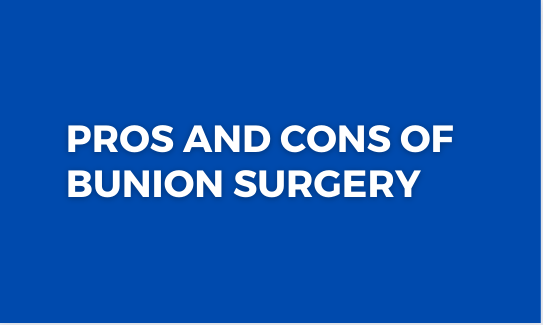Bunion surgery is a medical procedure performed to correct bunions, which are deformities of the foot that cause the big toe to deviate from its normal alignment. While bunion surgery can offer relief and improve foot function, it also comes with potential benefits and risks. Below are 40 pros and cons of bunion surgery, each explained in one sentence.
Pros:
- Pain relief: Bunion surgery can alleviate the pain and discomfort associated with bunions.
- Improved foot function: The surgery can restore proper alignment, allowing for improved foot function and mobility.
- Correction of deformity: Bunion surgery addresses the deformity of the big toe, improving its position and appearance.
- Increased comfort in shoes: Following surgery, patients may experience increased comfort when wearing shoes without pressure on the bunion.
- Prevention of further complications: Bunion surgery can prevent the progression of the deformity and potential complications that may arise.
- Enhanced quality of life: After recovering from surgery, patients often experience an improved quality of life due to reduced pain and increased mobility.
- Ability to engage in physical activities: Bunion surgery enables patients to participate in physical activities without discomfort or limitations.
- Correction of toe misalignment: Surgery can realign the big toe, correcting any overlapping or underlapping of adjacent toes.
- Improved foot appearance: Bunion surgery can enhance the aesthetic appearance of the foot by correcting the deformity.
- Long-term solution: Bunion surgery provides a long-lasting solution, potentially eliminating the need for ongoing conservative treatments.
- Potential for faster recovery: Some surgical techniques and advancements allow for quicker recovery times and return to normal activities.
- Reduced risk of infections: Surgery can eliminate any open wounds or ulcerations caused by the bunion, reducing the risk of infection.
- Customized surgical approach: Surgeons can tailor the surgical procedure based on the severity of the bunion and individual patient needs.
- Opportunity for concurrent foot corrections: In some cases, additional foot conditions or deformities can be addressed simultaneously during bunion surgery.
- Increased shoe options: Following surgery, patients may have a wider range of shoe options available to them.
- Relief from secondary foot conditions: Bunion surgery can alleviate secondary foot conditions caused by the deformity, such as corns or calluses.
- Improved weight distribution: Correcting the bunion can improve weight distribution across the foot, potentially reducing strain on other areas.
- Experienced medical professionals: Bunion surgeries are typically performed by experienced foot and ankle surgeons with specialized training.
- Minimal recurrence risk: When performed correctly, bunion surgery has a low risk of recurrence, providing long-term relief.
- Increased self-confidence: Successful bunion surgery can boost self-confidence by improving the appearance of the foot.
Cons:
- Potential complications: Bunion surgery carries the risk of complications, such as infection, nerve damage, or poor wound healing.
- Recovery period: The recovery process after bunion surgery may involve a prolonged period of limited mobility and restricted activities.
- Pain and discomfort post-surgery: Patients may experience pain, swelling, and discomfort during the initial recovery phase.
- Risk of overcorrection or undercorrection: There is a possibility that the surgical correction may result in overcorrection or undercorrection of the bunion deformity.
- Scarring: Bunion surgery can lead to visible scars, although surgeons strive to minimize their appearance.
- Limited shoe options during recovery: Patients may need to wear specific types of footwear during the recovery period, which can limit shoe choices.
- Potential for stiffness: Some individuals may experience stiffness or reduced range of motion in the affected toe joint after surgery.
- Possible need for additional surgeries: In certain cases, additional surgeries may be necessary to address complications or achieve optimal results.
- Risk of blood clots: Any surgical procedure carries a risk of developing blood clots in the leg veins.
- Adverse reaction to anesthesia: Some individuals may experience adverse reactions to anesthesia used during the surgery.
- Risk of delayed healing: Factors such as poor circulation or underlying health conditions can delay the healing process.
- Potential for toe numbness: Nerve damage during surgery can lead to temporary or permanent numbness in the toe or foot.
- Financial costs: Bunion surgery can be expensive, including surgical fees, anesthesia, and post-operative care.
- Lengthy rehabilitation process: Rehabilitation, including physical therapy, may be necessary to regain full foot function and strength.
- Temporary limitations in daily activities: Activities such as driving or walking long distances may be restricted during the initial recovery phase.
- Risk of unsatisfactory cosmetic result: Despite successful correction of the bunion, the final cosmetic outcome may not meet the patient’s expectations.
- Pre-existing health conditions: Certain medical conditions, such as diabetes or circulatory disorders, can increase the risks associated with bunion surgery.
- Potential for bone healing complications: In rare cases, bones may not heal properly after surgery, requiring additional interventions.
- Need for follow-up care: Patients may need ongoing follow-up appointments and care to monitor healing and address any issues.
- Uncertainty of outcomes: While bunion surgery aims for successful outcomes, individual results can vary, and complete pain relief is not guaranteed.
Pros
- Pain relief
- Improved foot function
- Correction of deformity
- Increased comfort in shoes
- Prevention of further complications
- Enhanced quality of life
- Ability to engage in physical activities
- Correction of toe misalignment
- Improved foot appearance
- Long-term solution
- Potential for faster recovery
- Reduced risk of infections
- Customized surgical approach
- Opportunity for concurrent foot corrections
- Increased shoe options
- Relief from secondary foot conditions
- Improved weight distribution
- Experienced medical professionals
- Minimal recurrence risk
- Increased self-confidence
Cons
- Potential complications
- Recovery period
- Pain and discomfort post-surgery
- Risk of overcorrection or undercorrection
- Scarring
- Limited shoe options during recovery
- Potential for stiffness
- Possible need for additional surgeries
- Risk of blood clots
- Adverse reaction to anesthesia
- Risk of delayed healing
- Potential for toe numbness
- Financial costs
- Lengthy rehabilitation process
- Temporary limitations in daily activities
- Risk of unsatisfactory cosmetic result
- Pre-existing health conditions
- Potential for bone healing complications
- Need for follow-up care
- Uncertainty of outcomes



